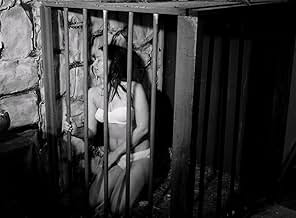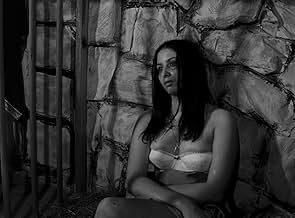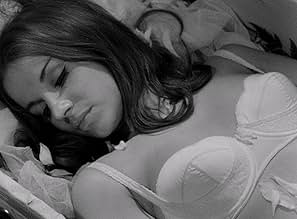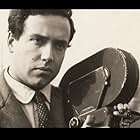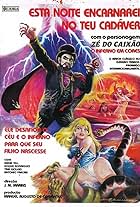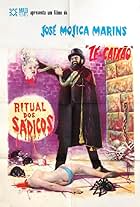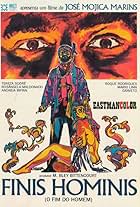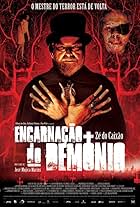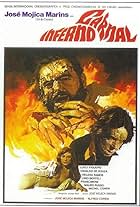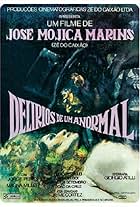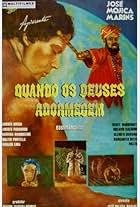le conta três episódios: um fabricante de bonecas cujas bonecas são perturbadoramente humanas, uma história de necrofilia e um médico prova que o amor está morto.le conta três episódios: um fabricante de bonecas cujas bonecas são perturbadoramente humanas, uma história de necrofilia e um médico prova que o amor está morto.le conta três episódios: um fabricante de bonecas cujas bonecas são perturbadoramente humanas, uma história de necrofilia e um médico prova que o amor está morto.
- Direção
- Roteiristas
- Artistas
Luiz Sérgio Person
- (segment "O Fabricante de Bonecas")
- (as L. S. Person)
Antônio Ravagnoli
- (segment "O Fabricante de Bonecas")
- (as Antonio F. Ravagnolli)
Ademar Silva
- (segment "O Fabricante de Bonecas")
- (as Ademir Silva)
- Direção
- Roteiristas
- Elenco e equipe completos
- Produção, bilheteria e muito mais no IMDbPro
Avaliações em destaque
Coffin Joe, the cult horror character created by Brazilian writer/director José Mojica Marins, hosts a trilogy of macabre tales.
First up is The Dollmaker, which sees a group of thugs breaking into the house of an elderly doll maker to look for an alleged stash of money. Unable to find any gold, the gang take a different kind of prize, raping the doll-maker's four beautiful daughters. The table are turned on the brutes, however, when the old man pulls a gun on the them, and the girls proceed to pluck out the mens' eyes for use in their new dolls. The plot for this one isn't anything special, with a predictable denouement, but it offers plenty of gratuitous T&A and the gory sight of the thugs' decapitated heads sans eyeballs.
The second story is Obsession, which seriously ups the weirdness ante. A balloon seller becomes obsessed with a beautiful woman, stalking her from a distance, carrying with him the box of new shoes dropped by woman during a shopping trip. On the woman's wedding day, she is stabbed and killed by a love rival. The balloon seller follows the woman's funeral procession to a crypt, which he breaks into after dark in order to fulfil his desires and return the lost shoes. A strangely lyrical tale told entirely without dialogue, Obsession tends to plod for much of its run-time, but ends in a satisfyingly twisted manner, the balloon seller breaking open the dead woman's coffin and stripping her corpse for a spot of necrophilia.
The last episode opens with the broadcast of a television debate show in which Professor Oaxiac Odez (Marins) expounds his theory that love doesn't exist. After the show, the professor invites a fellow panel member and his wife to his home, where he proceeds to shock and torture the couple in order to prove his ideology. As with his earlier Coffin Joe films, this one sees Marins' character waffling on incessantly about his lunatic philosophies, but also features plenty of exploitative content, including a man being spoon-fed molten metal, needles being pushed through flesh (for real), a sadistic acid attack, the wife drinking her husband's blood (fresh from the jugular) to quench her thirst, and a couple of gory scenes of cannibalism.
Probably not the kind of thing to appeal to casual horror fans, but those who dig weird cult world cinema should find this entertaining, especially if, like me, they also particularly enjoy the anthology format. One thing's for sure Marins' world is very strange indeed.
First up is The Dollmaker, which sees a group of thugs breaking into the house of an elderly doll maker to look for an alleged stash of money. Unable to find any gold, the gang take a different kind of prize, raping the doll-maker's four beautiful daughters. The table are turned on the brutes, however, when the old man pulls a gun on the them, and the girls proceed to pluck out the mens' eyes for use in their new dolls. The plot for this one isn't anything special, with a predictable denouement, but it offers plenty of gratuitous T&A and the gory sight of the thugs' decapitated heads sans eyeballs.
The second story is Obsession, which seriously ups the weirdness ante. A balloon seller becomes obsessed with a beautiful woman, stalking her from a distance, carrying with him the box of new shoes dropped by woman during a shopping trip. On the woman's wedding day, she is stabbed and killed by a love rival. The balloon seller follows the woman's funeral procession to a crypt, which he breaks into after dark in order to fulfil his desires and return the lost shoes. A strangely lyrical tale told entirely without dialogue, Obsession tends to plod for much of its run-time, but ends in a satisfyingly twisted manner, the balloon seller breaking open the dead woman's coffin and stripping her corpse for a spot of necrophilia.
The last episode opens with the broadcast of a television debate show in which Professor Oaxiac Odez (Marins) expounds his theory that love doesn't exist. After the show, the professor invites a fellow panel member and his wife to his home, where he proceeds to shock and torture the couple in order to prove his ideology. As with his earlier Coffin Joe films, this one sees Marins' character waffling on incessantly about his lunatic philosophies, but also features plenty of exploitative content, including a man being spoon-fed molten metal, needles being pushed through flesh (for real), a sadistic acid attack, the wife drinking her husband's blood (fresh from the jugular) to quench her thirst, and a couple of gory scenes of cannibalism.
Probably not the kind of thing to appeal to casual horror fans, but those who dig weird cult world cinema should find this entertaining, especially if, like me, they also particularly enjoy the anthology format. One thing's for sure Marins' world is very strange indeed.
I think that in the 60's you can talk about "modern" and "old" kind of horror films.The modernity of horror films was determined by the forces acting in the movie: immanent forces that eluded arcane solutions or mysterious set designing with dark, freakish and irrational characters, were forces related to a new notion of Horror. New Horror tried to find, to create, a new idea of terror closer to the "human body", an immanent and "rational" idea of terror.In this way George A. Romero's movies, with their political suggestions, are the more revolutionary in their genre and, well, i think that Marins' movies too, in their particular, experimental way, follow and reinvent the horror cinema modern notion born in 60's. In the beginning of this amazing picture Ze Do Caixao, presenting his three stories, says: "You cannot understand the terror because you are the terror!".In this statement resides the whole picture: especially the third story, the best one, shows that what scared us are the body's extremes, the "instincts" as Ze says.This argument by Marins\Do Caixao creates a modern notion of horror: filming this Marins checks new extreme forms of the bodies, a new way to be, a way that can be easily confused with sadism or with pure bizarre gory cinematographic entertainment.But Marin's way is really more radical than this kind of simple stuffs.It's an experimental way! Even if all the three stories are led by the same argument - the new notion of terror related by the new new notion of body - only the third one is successful to get the argument in a great complete visual way.Other two stories, especially the first one, are obvious and don't suggest anything new about searching a suitable image for the matter. Anyway, a good, funny too, modern and experimental horror picture. I give 9 to the third story and I give 7 1/2 to the whole picture.
'Strange World Of Coffin Joe' is my third Coffin Joe experience. For those not in the know "Coffin Joe" is the name Brazil's horror icon Jose Mojica Marins is known as in the English speaking world. Separating Marins the man from Coffin Joe the IDEA is extremely difficult, if not impossible. I can't think of any real equivalent of Coffin Joe in America or Britain. It's a bit like if Alfred Hitchcock was also Norman Bates... or something. Oh look, I can't even begin to explain what Coffin Joe is all about! Try watching 'At Midnight I'll Take Your Soul' and its sequel 'Tonight I'll Possess Your Corpse' first. Both are full of creepy low budget weirdness. Even then you might not be prepared for 'Strange World Of Coffin Joe'. For one thing it's an anthology with three separate stories (ala Bava's 'Black Sabbath'). On top of that Marins doesn't act in the first two segments (one about four baddies who invade a mysterious doll makers home to steal his loot and molest his daughters, the other about lyrical tale about obsessive desire and necrophilia told without dialogue), and when he appears in the final story he's not exactly the Coffin Joe we know and love(to hate) from the previous movies. He's no longer a bullying grave digger but a Doctor who is respected enough to get interviewed on a TV show called "The Men Who Make The News". One of the panellists who rejects Joe's philosophy on air accepts his invitation to visit his home, and he and his wife are put through an bizarre series of events to prove Joe's belief that love is dead and instinct conquers morality. Or something like that. Anyone who has seen other Coffin Joe movies knows the kind of stuff he spouts. This segment features some truly extraordinary images involving torture, perversion, cannibalism, and even in one did-I-really-see-that? bit, a terrified girl being taunted with a foot long hoagie. No, I'm not making that up. If you like weird low budget horror movies then you MUST check out Coffin Joe! Imagine the love child of Herschell Gordon Lewis and Jean Cocteau and you're getting there, but really Jose Mojica Marins is a true original. The more I see by him the more fascinated I am.
For his third film, José Mojica Marins a.k.a. Coffin Joe opted to do an omnibus style trio of horror tales, and it's a mixed bag. The title of the film is very apt, as Coffin Joe proved with his first two films that his 'world' is indeed very strange, and this film builds on that although none of the stories here follow the same plot thread as the other two and all of these tales stand alone - which is good news if you haven't seen the first two films, although you really should. Overall, this film isn't nearly as good as the earlier efforts; but it still offers a lot for the cult fan. The first tale revolves around a doll maker and a bunch of thieves who start out to rob him and end up finding out how the eyes in his dolls look so realistic (no prizes for guessing how). The second story is the weirdest and least good, and revolves around the ever-popular theme of necrophilia - and the final tale is an exploitation themed sick-fest in which the director takes the lead role. The plot revolves around his theories which relate to instinct and reason, and a journalist who is interested in seeing evidence.
Coffin Joe's directorial style is very flamboyant, and that's really what makes his films good. The themes on display have been copied often since the release of this film, and while I'm not sure if the films that went on to use the same ideas actually took influence from this one - it does have to be said that Coffin Joe's films are ahead of their time, especially considering that they hail from Brazil - a country not especially known for great films. As I mentioned, the trio of tales are a mixed bag and it comes as something of a disappointment that the first story is the best. There's a depressing tone that runs throughout the movie, and that is certainly felt in the first story - although not necessarily as much as in the others. The second story is definitely the least interesting, although the implications and atmosphere surrounding the story are well used. The third and final story will appeal most to exploitation fans, and is the most like the director's first two movies. Coffin Joe stars in this story in a role not too far removed from his trademark character. Overall, I wasn't overly impressed with this film - but the trippy and hypnotic atmosphere is a treat, and I'm sure fans of Coffin Joe will get a kick out of it.
Coffin Joe's directorial style is very flamboyant, and that's really what makes his films good. The themes on display have been copied often since the release of this film, and while I'm not sure if the films that went on to use the same ideas actually took influence from this one - it does have to be said that Coffin Joe's films are ahead of their time, especially considering that they hail from Brazil - a country not especially known for great films. As I mentioned, the trio of tales are a mixed bag and it comes as something of a disappointment that the first story is the best. There's a depressing tone that runs throughout the movie, and that is certainly felt in the first story - although not necessarily as much as in the others. The second story is definitely the least interesting, although the implications and atmosphere surrounding the story are well used. The third and final story will appeal most to exploitation fans, and is the most like the director's first two movies. Coffin Joe stars in this story in a role not too far removed from his trademark character. Overall, I wasn't overly impressed with this film - but the trippy and hypnotic atmosphere is a treat, and I'm sure fans of Coffin Joe will get a kick out of it.
"O Estranho Mundo de Zé do Caixão" is a collection of three creepy and bizarre horror tales.
"O Fabricante de Bonecas" ("The Dollmaker"): In Pirituba, Master Bastos is a respectable doll maker that lives with his four daughters in a remote area manufacturing dolls with impressive eyes. When four criminals break in his house to rob his money and rape his daughters, they learn why the doll's eyes are so realistic.
"Tara" ("Perversion"): A poor balloon seller has a crush on a young woman and stalks her. On her wedding day, the woman is stabbed in front of the church by another woman and dies. After her funeral, the man breaks in her crypt and spends the night with her to satisfy his obsession.
"Ideologia" ("Ideology"): After a debate on a TV show with the journalist Alfredo about the nonexistence of love, Professor Oaxiac Odez (José Mojica Marins) invites Alfredo and his wife Wilma to visit him. Professor Odez offers to prove to Alfredo that the instinct prevails over reason, and brings the couple to the dungeon of his house. They witness the results of the sinister experiment of Professor Odez with people that did not believe on his theory and after a period subjected to subhuman conditions, have become monstrous animals. Now Alfredo and Wilma are imprisoned and submitted to starvation and all sort of psychological torture to prove that the love is dead.
The first tale of violence, with heist and rape, is erotic and gore and has a predictable conclusion. The second tale explores an unusual theme, necrophilia without any dialog. The third one is the sickest tale, with cannibalism, torture, humiliation in an insane experiment of a deranged professor. My vote is seven.
Title (Brazil): "O Estranho Mundo de Zé do Caixão" ("The Strange World of Zé do Caixão")
"O Fabricante de Bonecas" ("The Dollmaker"): In Pirituba, Master Bastos is a respectable doll maker that lives with his four daughters in a remote area manufacturing dolls with impressive eyes. When four criminals break in his house to rob his money and rape his daughters, they learn why the doll's eyes are so realistic.
"Tara" ("Perversion"): A poor balloon seller has a crush on a young woman and stalks her. On her wedding day, the woman is stabbed in front of the church by another woman and dies. After her funeral, the man breaks in her crypt and spends the night with her to satisfy his obsession.
"Ideologia" ("Ideology"): After a debate on a TV show with the journalist Alfredo about the nonexistence of love, Professor Oaxiac Odez (José Mojica Marins) invites Alfredo and his wife Wilma to visit him. Professor Odez offers to prove to Alfredo that the instinct prevails over reason, and brings the couple to the dungeon of his house. They witness the results of the sinister experiment of Professor Odez with people that did not believe on his theory and after a period subjected to subhuman conditions, have become monstrous animals. Now Alfredo and Wilma are imprisoned and submitted to starvation and all sort of psychological torture to prove that the love is dead.
The first tale of violence, with heist and rape, is erotic and gore and has a predictable conclusion. The second tale explores an unusual theme, necrophilia without any dialog. The third one is the sickest tale, with cannibalism, torture, humiliation in an insane experiment of a deranged professor. My vote is seven.
Title (Brazil): "O Estranho Mundo de Zé do Caixão" ("The Strange World of Zé do Caixão")
Você sabia?
- CuriosidadesA 2023 reissue of this film and others in the Coffin Joe series was released by Arrow Video with artwork by Brazilian artist Butcher Billy.
- Citações
Zé do Caixão (Introduction): You can't accept the terror because you are the terror!
- Versões alternativasThe DVD version has a 3 minute color introduction, to a running time of 83 minutes.
- ConexõesEdited from O Estranho Mundo de Zé do Caixão (1968)
- Trilhas sonorasZé do Caixão
(musical theme)
Written by José Mojica Marins
Played by Titulares do Ritmo, and
Sung by Edson Lopes
Principais escolhas
Faça login para avaliar e ver a lista de recomendações personalizadas
- How long is The Strange World of Coffin Joe?Fornecido pela Alexa
Detalhes
- Data de lançamento
- País de origem
- Idioma
- Também conhecido como
- The Strange World of Coffin Joe
- Locações de filme
- Calçados Dima, São Paulo, São Paulo, Brasil(buying spree, in the segment "Tara")
- Empresa de produção
- Consulte mais créditos da empresa na IMDbPro
- Tempo de duração1 hora 20 minutos
- Cor
- Mixagem de som
- Proporção
- 1.37 : 1
Contribua para esta página
Sugerir uma alteração ou adicionar conteúdo ausente

Principal brecha
By what name was O Estranho Mundo de Zé do Caixão (1968) officially released in India in English?
Responda

